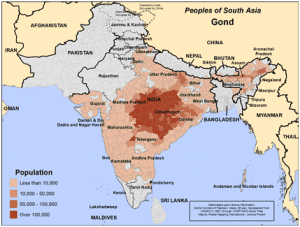HEALTH ISSUES
1. CERVICAL CANCER
THE CONTEXT: According to an observational study published in the Lancet Global Health journal, more than 6,00,000 new cases of cervical cancer and more than 3,40,000 deaths from the disease were reported around the world in 2020.
EXPLANATION:
About Cervical Cancer:
- It is a type of cancer that occurs in the cells of the cervix – the lower part of the uterus that connects to the vagina.
- Various strains of the Human papillomavirus (HPV) play a role in causing most cervical cancer.
- When exposed to HPV, the body’s immune system typically prevents the virus from doing harm. In a small percentage of people, however, the virus survives for years, contributing to the process that causes some cervical cells to become cancer cells.
- The HPV vaccine (Cervarix) protects against two of the cancer-causing strains, which are HPV 16 and 18.
Human papillomavirus:
- Human papillomavirus (HPV) is the most common viral infection of the reproductive tract.
- There are more than 100 types of HPV.
- More than 40 types of HPV are spread through direct sexual contact.
- Out of these 40, two cause genital warts, while about a dozen of HPV cause different types of cancer including cervical, anal, oropharyngeal, penile, vulvar and vaginal.
About the study findings:
India reported 1,23,907 new cases of cervical cancer and 77,348 deaths, according to the study.
Incidence:
- In 2020, overall incidence was 13 per 1,00,000 women; mortality was 7 per 1,00,000 women.
- As many as 172 out of the 185 countries saw more than the 4 cases per 1,00,000 women per year threshold for elimination set by the World Health Organisation (WHO).
- The development of effective vaccination against the human papilloma virus (HPV), which causes cervical cancer, and screening programmes have made cervical cancer a largely preventable disease.
SCIENCE AND TECHNOLOGY
2. AERONOMY
THE CONTEXT: Union Minister of State (Independent Charge) Science & Technology recently informed that ISRO has taken initiatives for feasibility studies on missions to Venus as well as Aeronomy studies.
THE EXPLANATION:
About Aeronomy:
- It refers to the scientific study of the upper atmospheric regions of the Earth and other solar
 system bodies.
system bodies. - It includes the distribution of temperature, density, and chemical constituents, and the chemical reactions that occur.
- It also includes the studies of aurora, airglow, the ionosphere, Van Allen radiation belts, cosmic rays, and radiative and photochemical phenomena.
- It covers the chemistry, dynamics and energy balance of both neutral and charged particles.
SECURITY AFFAIRS
3. DRAFT CYBERSECURITY STRATEGY
THE CONTEXT: The National Security Council Secretariat (NSCS) has formulated a draft National Cyber Security Strategy, which holistically looks at addressing the issue of security of national cyberspace.
THE EXPLANATION:
Draft National Cyber Security Strategy:
Guiding Principles:
- Risk-based approach: To be adopted by the private sector, the government, academia and civil society in assessing and responding to cyber-related threats or issues.
- Multi-stakeholder approach: To enhance the effectiveness of all key stakeholders in improving the cybersecurity posture by recognizing the various roles and responsibilities of different stakeholders.
- External Co-operation: The Strategy will also promote bilateral, regional and international cooperation, recognizing the borderless nature of cyberspace.
- Respect for the rule of law and human rights: To promote, protect fundamental human rights and freedoms of citizens.
- Capacity development: To address fast changing cybersecurity issues and developments.
- Socio-economic development: To ensure cyberspace is fully leveraged by broader socio-economic development, facilitate sustainable socio-economic development across the entire nation.
- Addressing Cybercrime: To promote and facilitate both individual and collective action in tackling cybercrime.
The National Security Council Secretariat (NSCS):
Background:
- The National Security Council (NSC) of India is an executive government agency established in 1998 and tasked with advising the Prime Minister’s Office on matters of national security and strategic interest.
- The NSC is the apex body of the 3-tiered structure of the national security management system in India.
- The 3-tiers are the Strategic Policy Group, the National Security Advisory Board and a secretariat from the Joint Intelligence Committee (JIC).
About National Security Council Secretariat (NSCS) –
- NSCS is the apex agency looking into the political, economic, energy and strategic security concerns of India.
- National Cyber Security Coordinator (NCSC) works under NSCS and coordinates with different agencies at the national level for cyber security matters.
PRELIMS PERSPECTIVE
4. GOND COMMUNITY
THE CONTEXT: Recently,Rajya Sabha passed the Constitution (Scheduled Castes and Scheduled Tribes) Order (Second Amendment) Bill that aims to move the Gond community from the Scheduled Castes list to Scheduled Tribes list in four districts of Uttar Pradesh (Chandauli, Kushinagar, Sant Kabir Nagar, and Sant Ravidas Nagar)
THE EXPLANATION:
Gond tribe
- They are the tribal community mostly found in the Gond forests of the central India.
- They are widely spread in the states of Madhya Pradesh, Chattisgarh, Maharashtra, Andhra Pradesh and Orissa.
- The name by which the Gonds call themselves is Koi or Koitur which means unclear.
- Gonds are one of the largest tribal groups in the world.
Background:
- In the fourteen century, they ruled several parts of the central India.
- They had built number of forts, palaces, temples, tanks and lakes during the rule of the Gonds dynasty.
- Gonds have been the warriors since the British period.
- During the British regime in India, Gonds challenged the Britishers in several battles.
Language
- They speak Gondi and Indo-Aryan languages
- The Gondi language belongs to the Dravidian family of languages and is related to Tamil and Kannada.
Festivals
- Their fairs and festivals are influenced from the Hindu traditions.
- Keslapur Jathra is an important festival of the Gonds.
- Madai is another major festival celebrated among the Gonds.
- They also celebrate Hindu festival called Dussehra.
Dance
- Gusadi dance is the most famous dance performed by them.
- It is performed by wearing head gears decorated with the peacock feathers.
- They wear cotton cloth around their waist.
- They smear ash all over their body and the beards made of animal hair is also an important part of the dance costumes.

5. GEOGRAPHICAL INDICATION TAG SOUGHT FOR BEYPORE URU
THE CONTEXT: Recently, the District Tourism Promotion Council, Kozhikode has applied for a Geographical Indication (GI) tag for the famous Beypore Uru (boat).
THE EXPLANATION:
- The name Uru is associated with the traditional ship building culture of Kerala, a culture that
 has been throbbing with life on these shores for the last 1500 years.
has been throbbing with life on these shores for the last 1500 years. - It is a wooden dhow (ship / sailing boat / sailing vessel) handcrafted by skilled artisans and carpenters in Beypore, Kerala.
- The Beypore Urus are purely made of premium wood, without using any modern techniques. The wood used to build the Uru is still sawed the traditional way which requires immense expertise. Today, many artisans involved in Uru-making are over 50-70 years old and have been in the profession since their fathers passed on the tradition to them.
VALUE ADDITION:
- GI tag is the abbreviation of Geographical Indications tags in India. It came into force with effect from 15th September 2003.
- A geographical indication (GI) is a sign used on products with a specific geographical origin and possesses qualities or a reputation due to that origin.
- This tag is valid for 10 years and can be renewed.
- Geographical Indications protection is granted through the TRIPS Agreement.
- The Geographical Indication Registry issues this tag under the Department of Industry Promotion and Internal Trade, Ministry of Commerce and Industry.
- Geographical indications are typically used for agricultural products, foodstuffs, wine and spirit drinks, handicrafts, and industrial products.
- The Gucchi mushroom, one of the most expensive mushrooms in the world, from the state of Jammu and Kashmir was recently given the GI tag in India.
Benefits of GI Tags
- A geographical indication right enables those who have the right to use the indication to prevent its use by a third party whose product does not conform to the applicable standards.
- Geographical indication tags are given to the products to protect the goods Legally.
- Preventing unauthorized or illegal use of geographical indication tags by others.
- Helping customers in getting the original items that contain all the specific traits.
- Promoting the economic prosperity of manufacturers/ producers of items under GI tags. Items with GI tags get enhanced demand in national and international markets.

 has been throbbing with life on these shores for the last 1500 years.
has been throbbing with life on these shores for the last 1500 years.